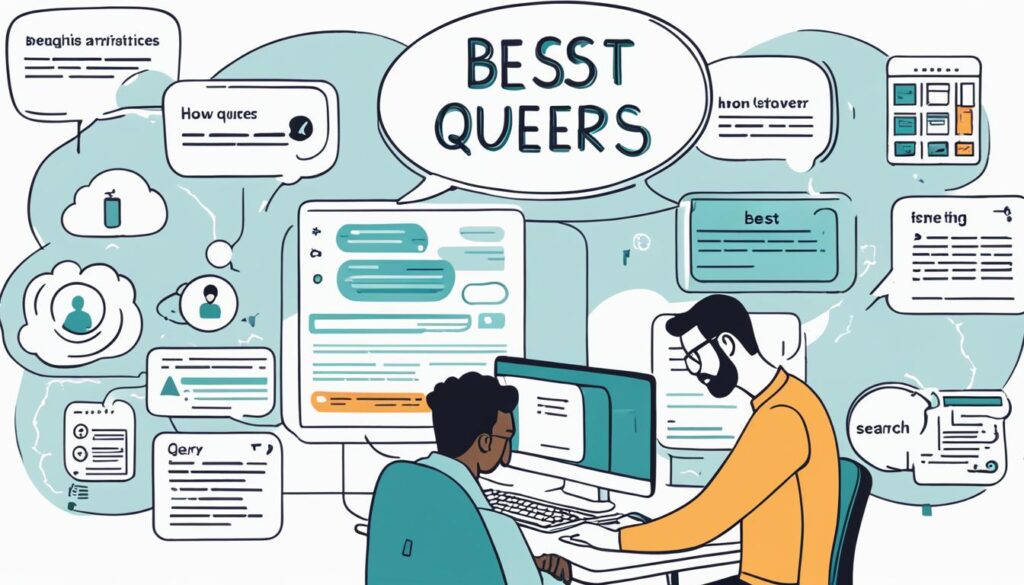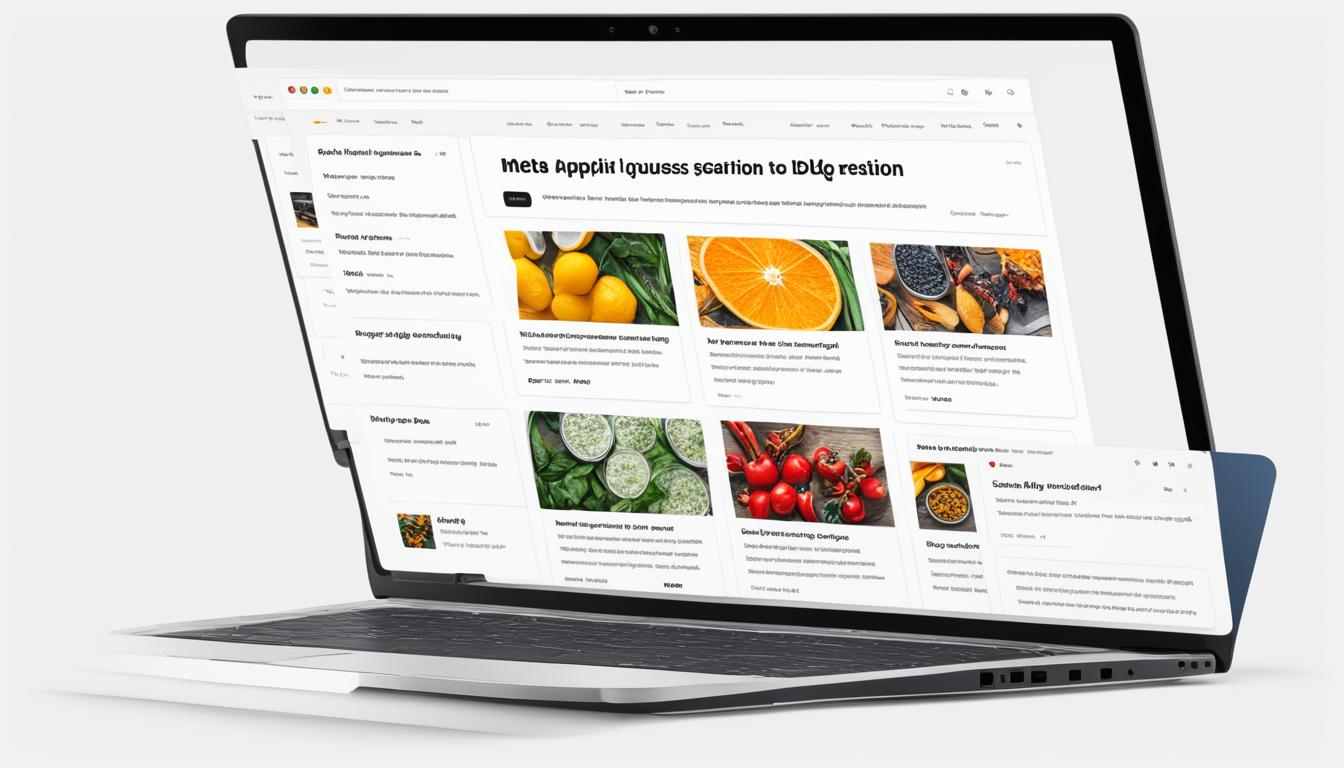Hi there! I’m excited to share some valuable SEO copywriting tips for boosting engagement on your website. With these techniques, you can create captivating content that not only attracts visitors but also optimizes your content for search engines. Let’s dive in!
When it comes to copywriting, engaging your audience is key. By using effective copywriting techniques, you can create content that resonates with your readers and keeps them coming back for more. But it’s not just about crafting compelling words – it’s also about optimizing your content for search engines to increase your website’s visibility.
To improve user experience and boost engagement, here are some essential SEO tips:
Key Takeaways:
- Create engaging and informative content that resonates with your audience.
- Optimize your website’s content by using relevant keywords strategically.
- Focus on improving user experience and implementing website engagement strategies.
- Understand your target audience’s needs and preferences to tailor your content effectively.
- Keep up with the latest SEO trends and adapt your copywriting techniques accordingly.
By following these SEO copywriting tips, you can enhance user engagement, optimize your website’s content, and effectively write for SEO. So go ahead, apply these strategies, and watch your website’s engagement soar!
The Importance of User Engagement in SEO
User engagement plays a vital role in search engine optimization (SEO) and improving search engine rankings. Search engines prioritize delivering the best user experience, so engaging content that keeps visitors on your website for longer can lead to a boost in rankings.
To optimize your content for user engagement and enhance your website’s performance, it is crucial to focus on creating an exceptional user experience and providing valuable, insightful, and engaging content. By implementing effective on-page optimization techniques and strategies, you can captivate your audience and improve your website’s visibility in search results.
“Engaging content that keeps visitors on your website for longer can lead to a boost in rankings.”
The key to user engagement lies in understanding your target audience and crafting content that resonates with their needs and preferences. By conducting thorough research on your audience, you can identify their pain points, interests, and queries to address through your content. This enables you to provide valuable answers and insights that keep users engaged and satisfied.
An exceptional user experience involves seamless website navigation, fast loading speeds, and intuitive design. By optimizing your website’s performance, you can enhance user engagement and encourage visitors to explore your content further. This can lead to longer sessions, lower bounce rates, and ultimately, a boost in search engine rankings.
“Remember, engaging content and an exceptional user experience go hand in hand when it comes to optimizing your website for search engine rankings.”
Effective Strategies for Boosting User Engagement:
- Create compelling headlines and meta descriptions that entice users to click through to your content
- Format your content for readability by using subheadings, shorter paragraphs, and bullet points
- Incorporate relevant images, videos, and other multimedia elements to enhance user engagement
- Encourage user interaction through comments, social media sharing, and calls to action
- Promote internal linking to guide users to related content and keep them engaged on your website
The Benefits of User Engagement:
| Improved Search Engine Rankings | Enhanced User Experience | Increased Organic Traffic |
|---|---|---|
| Engaging content and longer session durations contribute to higher search engine rankings | Exceptional user experience leads to increased user satisfaction and repeat visits | User engagement increases the likelihood of users sharing your content and attracting organic traffic |
| Higher rankings result in greater visibility and exposure to your target audience | Positive user experiences can lead to higher conversion rates and business growth | Organic traffic from engaged users tends to have higher conversion rates and lifetime value |
By prioritizing user engagement and optimizing your website for an exceptional user experience, you can boost your search engine rankings, attract more organic traffic, and ultimately achieve your SEO goals.
Common Mistakes to Avoid in SEO Copywriting

When it comes to SEO copywriting, there are several common mistakes that can hinder your success. Avoiding these pitfalls is crucial for optimizing your website’s content and attracting organic traffic. Let’s take a closer look at some of these mistakes:
- Not optimizing title tags and H1 headings: Your title tags and H1 headings play a crucial role in optimizing your content for search engines. Failing to include your target keyword in these elements can prevent search engines from understanding the relevance of your content.
- Overemphasizing semantic keywords: While it’s important to include relevant keywords in your content, overusing them can make your writing sound unnatural. Instead, focus on creating comprehensive and cohesive content that provides value to your readers.
- Providing overly in-depth content: While comprehensive content is essential, it’s important to strike a balance. Overwhelming your audience with excessive information can lead to a loss of interest and engagement. Keep your content concise, engaging, and easy to digest.
- Failing to thoroughly understand your target audience: To create content that resonates with your audience, it’s crucial to deeply understand their pain points, preferences, and needs. Without this understanding, your content may miss the mark and fail to engage your target audience effectively.
To avoid these common mistakes, focus on optimizing your title tags and headings, utilizing semantic keywords organically, creating comprehensive yet concise content, and conducting thorough audience research. By addressing these key areas, you can enhance your SEO copywriting strategies and maximize your website’s visibility and engagement.
Remember, SEO copywriting is not just about pleasing search engines; it’s about providing valuable content that meets the needs of your audience.
Mistakes to Avoid in SEO Copywriting
| Mistake | Description |
|---|---|
| Not optimizing title tags and H1 headings | Failure to include target keywords in these elements can impact search engine rankings. |
| Overemphasizing semantic keywords | Using too many semantic keywords can make the content sound forced and unnatural. |
| Providing overly in-depth content | Overwhelming the audience with excessive information can lead to disengagement. |
| Failing to thoroughly understand the target audience | Without understanding the audience’s needs, the content may miss the mark. |
Optimizing for Experience, Expertise, Authority, and Trust (EEAT)

Google’s EEAT guidelines highlight the significance of experience, expertise, authority, and trust in content. To optimize for EEAT, I’ve found that incorporating words like “in my experience” and “I’ve discovered”, establishes a personal connection and adds credibility to my content. Linking out to trusted sources and including anecdotal examples further enhances the level of trust and expertise portrayed within the article. Anecdotes provide real-life experiences that resonate with readers, illustrating the practical application of the information presented.
It’s critical to optimize on-page SEO elements such as author bios and backlinks from reputable sources. By including a comprehensive author bio that showcases expertise and credentials, readers can trust the information more readily. Additionally, backlinks from authoritative sites or industry leaders lend credibility to the content and strengthen my website’s reputation.
A strong brand reputation is key to establishing authority and trust with readers. By consistently delivering high-quality, valuable content, I can build a strong brand reputation and gain the trust of my target audience. People are more likely to engage with content from brands they trust, increasing the visibility and reach of my content.
In summary, optimizing for experience, expertise, authority, and trust is crucial for creating content that resonates with readers and builds a strong brand reputation. By incorporating personal experiences, trust signals like author bios and backlinks, and maintaining a strong brand reputation, I can optimize my content for maximum engagement and credibility.
Prioritizing User Engagement Signals and Time on Page

Google places a significant emphasis on user engagement signals, such as time on page, as a key factor in determining the quality and relevance of content. To optimize your website for user engagement and improve time on page metrics, it’s essential to focus on creating high-quality, captivating content and enhancing the overall user experience.
One effective way to keep users engaged is through captivating storytelling. By incorporating storytelling techniques into your content, you can create a compelling narrative that hooks readers and encourages them to stay on your page longer. Use vivid and descriptive language, evoke emotions, and craft a storyline that captures their attention from the start.
Another important aspect of user engagement is content quality. Ensure that your content is well-researched, accurate, and provides value to your audience. Use credible sources, statistics, and examples to support your points and reinforce your expertise.
Additionally, consider incorporating visual elements such as graphics, screenshots, and infographics to enhance the visual appeal of your content. Visuals can not only break up the text but also provide a visual representation of the information you’re presenting, making it easier to understand and more engaging for your audience.
Organizing your content using subheadings and utilizing short sentences and paragraphs can significantly improve readability and keep users engaged. Break your content into easily digestible sections that are skimmable, allowing readers to quickly find the information they’re looking for.
Finally, always strive to improve the overall user experience on your website. Ensure that your website is easy to navigate, loads quickly, and is mobile-friendly. A seamless and intuitive user experience will encourage users to stay on your page longer and explore more of your content.
By prioritizing user engagement signals and focusing on improving time on page, you can create a captivating user experience that not only keeps your audience engaged but also signals to search engines that your content is valuable. This, in turn, can help boost your website’s rankings and drive more organic traffic to your site.
By incorporating these strategies into your SEO copywriting efforts, you can enhance the overall user experience and improve user engagement signals, ultimately driving better results for your website.
Understanding Search Intent and Providing Valuable Answers

Understanding search intent is a fundamental aspect of effective SEO copywriting. It involves analyzing user queries and crafting valuable content that directly addresses their needs. By satisfying user intent, you enhance the relevance of your website and increase your chances of ranking higher in search results.
When users search for information, they have different intentions or goals in mind. Some queries may require informational content, such as blog posts or articles that provide detailed explanations. Others may have transactional intent, seeking specific products or services.
Analyzing user queries and segmenting them according to search intent enables you to tailor your content to meet those specific needs. By identifying the intent behind different queries, you can create content that aligns with and fulfills those intentions, increasing the chances of attracting and engaging your target audience.
Researching the questions people ask related to your industry is key. By understanding the most common queries, you can identify the gaps in existing content and provide comprehensive answers that add value. This not only positions you as an authority in your field but also helps you capture relevant organic traffic.
One effective strategy is to create FAQs or Q&A blog posts that directly address the common questions users have. By structuring your content to provide clear and concise answers, you can satisfy user intent and enhance the user experience. This approach also allows search engines to identify your content as relevant and valuable, further increasing your visibility in search results.
“Understanding user intent is like having a map that guides me in crafting valuable content. By answering the questions users are asking, I can provide the information they seek and establish trust.” – SEO Copywriter
To summarize, understanding search intent is crucial in SEO copywriting. By analyzing user queries and providing valuable answers, you can create content that satisfies user intent and boosts your website’s visibility. By researching common questions and addressing them comprehensively, you can engage your target audience and improve your chances of ranking higher in search results. Let’s dive deeper into optimizing on-page elements in the next section, which significantly impact click-through rates and user experience.
Optimizing On-Page Elements for Improved Click-Through Rates

When it comes to SEO, optimizing on-page elements is crucial for improving click-through rates and enhancing user experience. By strategically implementing title tags, meta descriptions, and headers, you can boost the visibility of your content in search results and entice users to click on your website. Let me share some valuable tips on how to optimize these on-page elements to drive more traffic and engagement.
Include Target Keywords in Title Tags and Meta Descriptions
One of the most effective ways to optimize on-page elements is by incorporating your target keywords in title tags and meta descriptions. These HTML tags play a significant role in search engine rankings and provide searchers with a glimpse of what your content offers.
For instance, if you’re writing a blog post about “SEO copywriting tips,” make sure to include this keyword within the title tag and meta description. By doing so, you’re signaling to search engines that your content is relevant to this specific query, which can improve your click-through rates.
Create Clear and Informative Headers
Headers are an essential on-page element that helps organize and structure your content. By using clear and informative headers such as H1, H2, and H3 tags, you’re making it easier for both search engines and users to understand the main topics covered in your content.
When creating headers, aim for concise and descriptive wording that accurately reflects the content below. This not only improves readability and user experience but also helps search engines in understanding the relevance and context of your content.
Enhance Readability for Better Engagement
Readability is a critical factor in user engagement and click-through rates. When visitors land on your website, they should find it easy to read and understand your content. To enhance readability, consider the following strategies:
- Use short paragraphs and bullet points to break up your content.
- Write in a conversational tone that resonates with your target audience.
- Ensure your sentences are clear, concise, and free of jargon.
By optimizing your content for readability, you can create a seamless browsing experience that encourages users to stay engaged and explore more of your website.
On-Page Optimization Checklist
| On-Page Element | Optimization Tips |
|---|---|
| Title Tags | Include target keywords, keep it concise (around 50-60 characters), and make it compelling. |
| Meta Descriptions | Write persuasive, concise descriptions (around 150-160 characters) and include target keywords. |
| Headers (H1, H2, H3) | Use clear and descriptive headers that accurately reflect the content below. |
| Readability | Break up content with short paragraphs, use bullet points, and write in a conversational tone. |
By optimizing these on-page elements and focusing on readability, you can improve your click-through rates and provide a better user experience. Remember, the goal is to entice users to click on your website and engage with your content, ultimately driving more organic traffic and achieving your SEO goals.
By following these tips, you’ll be well on your way to optimizing your on-page elements for improved click-through rates and user engagement. Remember, the key is to provide valuable and relevant content that resonates with your target audience and encourages them to take action.
Conclusion
SEO copywriting is the key to improving engagement, search engine optimization, and user experience. By incorporating effective copywriting techniques, creating valuable and engaging content, optimizing on-page elements, and understanding user intent, you can captivate your audience and boost your website’s visibility in search results.
By following these SEO copywriting tips, you can enhance user engagement and optimize your website’s content for maximum impact. Remember to write with the user in mind, providing valuable information, addressing their needs, and delivering captivating storytelling. This will not only improve user experience but also increase your chances of higher rankings by search engines.
Additionally, optimizing on-page elements such as title tags, meta descriptions, and headers can significantly impact click-through rates. By accurately describing your content, using clear and informative headings, and organizing your content for readability, you can attract more clicks and keep users engaged.
So, whether you’re creating blog posts, product descriptions, or landing pages, always focus on SEO copywriting to ensure your content appeals to both search engines and your target audience. By implementing these strategies, you can effectively write for SEO, enhance user engagement, and boost your website’s visibility and success.










